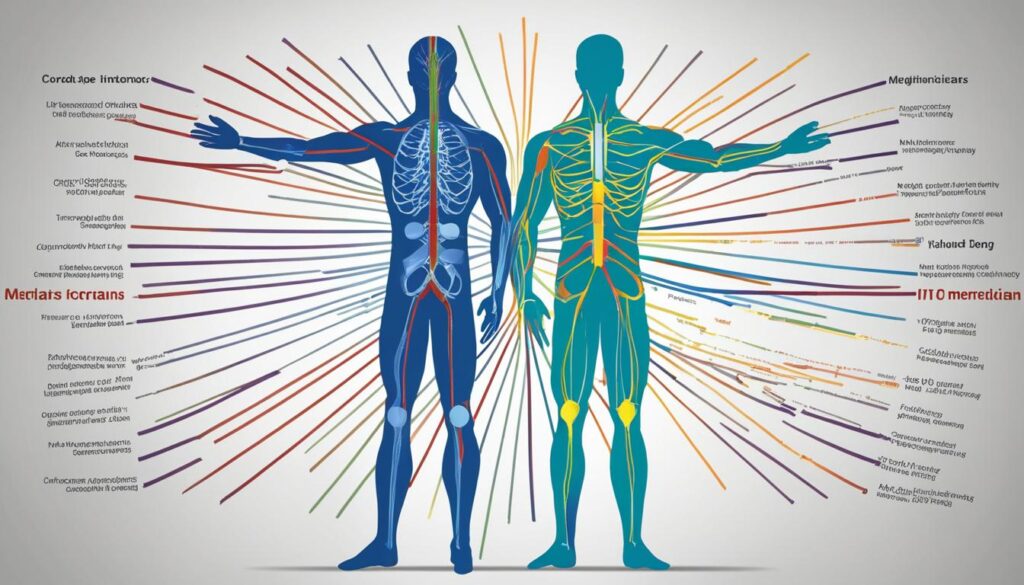
The intricate tapestry of body meridians is a cornerstone of traditional Chinese medicine (TCM); a system believed to guide the flow of energy, or qi, essential to our vitality. This ancient framework consisting of interconnected pathways has informed holistic healing practices for millennia. Through the delicate art of acupuncture and the precise stimulation of acupoints along the meridian system, TCM practitioners aim to balance the vital energy within our bodies. Uncovering the mysteries of the acupuncture meridian may yield profound insights into the harmonization of our physical and spiritual planes, adhering to the principles of yin and yang that dictate equilibrium in the natural world.
The principles of TCM and the application of alternative medicine techniques such as acupuncture treatment have permeated Western culture, reinforcing their validity in the realm of complementary and alternative medicine. By understanding and utilizing the energy flow through body meridians, we open ourselves to a spectrum of healing possibilities beyond the scope of conventional medicine.
Key Takeaways
- Body meridians are integral to TCM and holistic health.
- Qi circulation is key for maintaining life’s energy and vitality.
- Understanding meridians can aid in a whole-person approach to healing.
- Acupuncture and acupressure are practical applications of meridian knowledge.
- Yin and yang are fundamental concepts used to restore balance within the meridian system.
- Practices rooted in TCM continue to complement modern health care.
Understanding the Meridian System and Its Significance
In the holistic practice of Traditional Chinese Medicine (TCM), the concept of meridians is fundamental to understanding how energy in your body flows. The meridian system, a key component of TCM, is often described as an intricate network of pathways that facilitate the circulation of qi, or life energy. This system includes 12 principal meridians, each associated with a different organ system and serving as a channel for the flow of qi, which is essential for maintaining health and balance within the body.
These primary meridians are considered the body’s meridians’ highways, each acupoint acting as a node through which meridian energy can be accessed or influenced. Rooted deeply in the part of Traditional Chinese Medicine that governs both diagnosis and treatment, the acupuncture points and meridians are believed to be strategically placed to tap into this energy system effectively. When the energy flow in these pathways is balanced, the body is in a state of health. Conversely, blockages or imbalances in the meridian energy can lead to discomfort or illness, demonstrating the profound effects of acupuncture in restoring balance.
- The meridian pathways are responsive to various stimuli, including pressure, needles, and heat.
- Acupoint stimulation is used to correct imbalances in the flow of qi, with the objective of relieving symptoms and promoting well-being.
- Understanding the concept of meridians offers insights into how different parts of the body interconnect energetically.
Meridians are not merely abstract concepts; they are integral to the fabric of traditional Chinese medicine (TCM) and its approach to health. Whether used in conjunction with other forms of medicine or as a standalone system, the understanding and application of the meridian system’s principles is a testament to the enduring legacy of TCM in enhancing health and wellness.
Exploring Body Meridians: Unraveling the Paths of Energy
Embarking on a journey through the intricacies of the meridian system reveals the rich tapestry of 12 meridians that make up the core of Traditional Chinese Medicine (TCM). These vital energy pathways are fundamental in understanding how qi, or life energy, flows throughout the body, promoting health and equilibrium.
The Twelve Major Meridians and Their Corresponding Organs
Each of the twelve primary meridians corresponds to vital organs within the body, forming an interconnected network essential for the smooth circulation of qi. These pathways include both yin and yang meridians, with the former linked to organs that store energy and the latter to organs that are more active and release energy:
| Yin Meridians | Corresponding Organs | Yang Meridians | Corresponding Organs |
|---|---|---|---|
| Heart Meridian | Heart | Small Intestine Meridian | Small Intestine |
| Kidney Meridian | Kidney | Bladder Meridian | Bladder |
| Spleen Meridian | Spleen | Stomach Meridian | Stomach |
| Lung Meridian | Lungs | Large Intestine Meridian | Large Intestine |
| Pericardium Meridian | Pericardium | Gallbladder Meridian | Gallbladder |
| Liver Meridian | Liver | Sanjiao Meridian (Triple Warmer) | Metabolic Balance |
Qi: The Vital Energy Flowing Through Meridians
Central to the functionality of the meridian system is qi, the vital force that sustains life. Qi flows through these energy channels, carrying both inherited qi from birth and gong qi, acquired from daily nourishment and air. Disruptions in qi flow can impact health, leading to issues that might manifest as physical ailments or emotional disturbances.
Yin and Yang: Balancing the Energies within the Meridian System
The foundational principle of yin and yang governs the meridian system and ensures a natural balance of energy within the body. The yin meridians are linked to the body’s solid, nurturing organs, while the yang meridians correspond to more energetic and functional organs. This system, inclusive of the five elements, guarantees that energy circulates in harmony, reflecting TCM’s holistic perspective on health.
Acupuncture Points: Gateways to Enhance Energy Flow
The strategic application of acupuncture points along the meridians can significantly influence the body’s energy balance. These gateways allow for various modalities of stimulation, such as acupressure, needle techniques, and cupping, to release blockages and promote an optimal flow of energy, Qi, akin to a circulatory system not of blood or oxygen, but of vital life force.

Conclusion
The intricate map of body meridians embedded in the philosophies of Traditional Chinese Medicine (TCM) stands as a testament to the enduring legacy of natural healing practices. It is through the deep understanding of these meridian pathways that the full potential of holistic healing can be realized. Maintaining the harmonious energy flow and qi flow within these pathways is not just an esoteric concept, but a practical approach to enhancing one’s health and vitality.
Modalities like acupuncture and acupressure are more than mere procedures; they are profound methods of accessing and influencing the body’s life energy, promoting balance and encouraging the body’s intrinsic ability to heal. These practices, rooted in centuries of wisdom, offer an alternative to conventional medicine by focusing on the balance of energy between yin and yang, which is fundamental for achieving both physical and mental well-being.
In the modern landscape of healthcare, the principles of energy medicine and meridian therapy provide valuable insights into the interconnectedness of body systems and the importance of energetic balance. As we continue to explore and integrate these ancient teachings, we pave the way for more comprehensive approaches to well-being, where the nurturing of vitality pathways is as critical as treating symptoms. It is in this convergence of time-tested tradition and contemporary understanding that we find a holistic path to thriving health.
FAQ
What are body meridians in Traditional Chinese Medicine?
Body meridians are pathways within the body through which qi, or vital energy, flows. In Traditional Chinese Medicine (TCM), these meridians form a complex network that is essential for holistic healing and the proper functioning of bodily processes.
How is acupuncture related to the meridian system?
Acupuncture involves the insertion of thin needles into specific acupuncture points, or acupoints, located along the body’s meridians. This practice is designed to regulate and balance the flow of energy, correct disruptions, and promote health and well-being.
What is qi and why is it important?
Qi is the concept of vital energy that circulates through the body’s meridians. It is fundamental to sustaining life and maintaining the functions of organs and tissues. In TCM, a balanced and free-flowing qi is pivotal for overall health.
Can understanding meridians improve mental health?
Yes, according to TCM, there is a close relationship between the body’s meridians and emotional states. Balancing the energy flow through meridians can have a positive effect on mental health and aid in managing stress and fostering emotional well-being.
What are the 12 principal meridians?
The 12 principal meridians in TCM correspond to major organs in the body: lung, large intestine, stomach, spleen, heart, small intestine, bladder, kidney, pericardium, triple warmer, gallbladder, and liver. They ensure the flow of qi and maintain the body’s energy balance.
How do yin and yang relate to meridians?
Yin and yang represent opposing but complementary forces or energies within the body. Each meridian is associated with either yin or yang energies, and they must be in balance for optimal health. This duality helps regulate the flow of qi in the body’s meridians.
What are acupuncture points and how do they function?
Acupuncture points, or acupoints, are specific locations on the body where meridians come to the surface. Stimulating these points through acupuncture or acupressure can help modulate the energy flow, relieve blockages, and trigger the body’s natural healing mechanisms.
Is there scientific evidence supporting the effectiveness of acupuncture?
Yes, numerous studies have provided evidence for the effectiveness of acupuncture in treating various conditions. For instance, the National Institutes of Health acknowledges acupuncture as a beneficial treatment for certain types of pain and other health issues.
What are alternative ways to stimulate acupuncture points besides needles?
Other methods to stimulate acupuncture points include acupressure, which uses manual pressure, as well as cupping, moxibustion, laser therapy, and electrical stimulation. These techniques aim to enhance the flow of qi without the use of needles.
Can meridian therapy be integrated with Western medicine?
Meridian therapy can complement Western medicine by addressing the energetic aspects of health. Many patients use it as part of an integrated approach to treatment, combining the benefits of both Eastern and Western medical traditions.
Are there any risks associated with treatments that involve meridians?
When performed by a licensed and trained practitioner, treatments like acupuncture are generally safe. Potential risks are minimal but can include discomfort, minor bruising, or bleeding at needle sites. It’s important to consult with a healthcare provider before beginning any alternative treatment.
Can everyone benefit from understanding their body’s meridians?
While individual experiences may vary, understanding the concept of body meridians can be beneficial for anyone looking to enhance their overall health and vitality. This knowledge can guide practices for maintaining energy balance and promoting self-healing.






